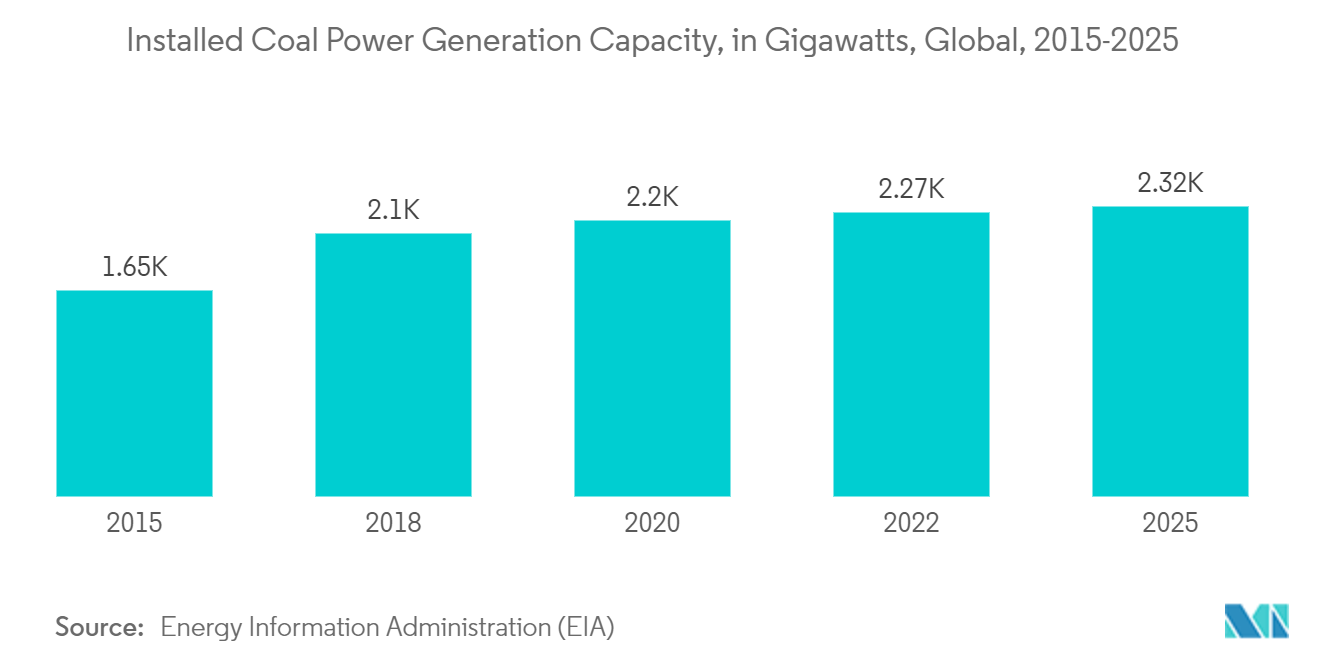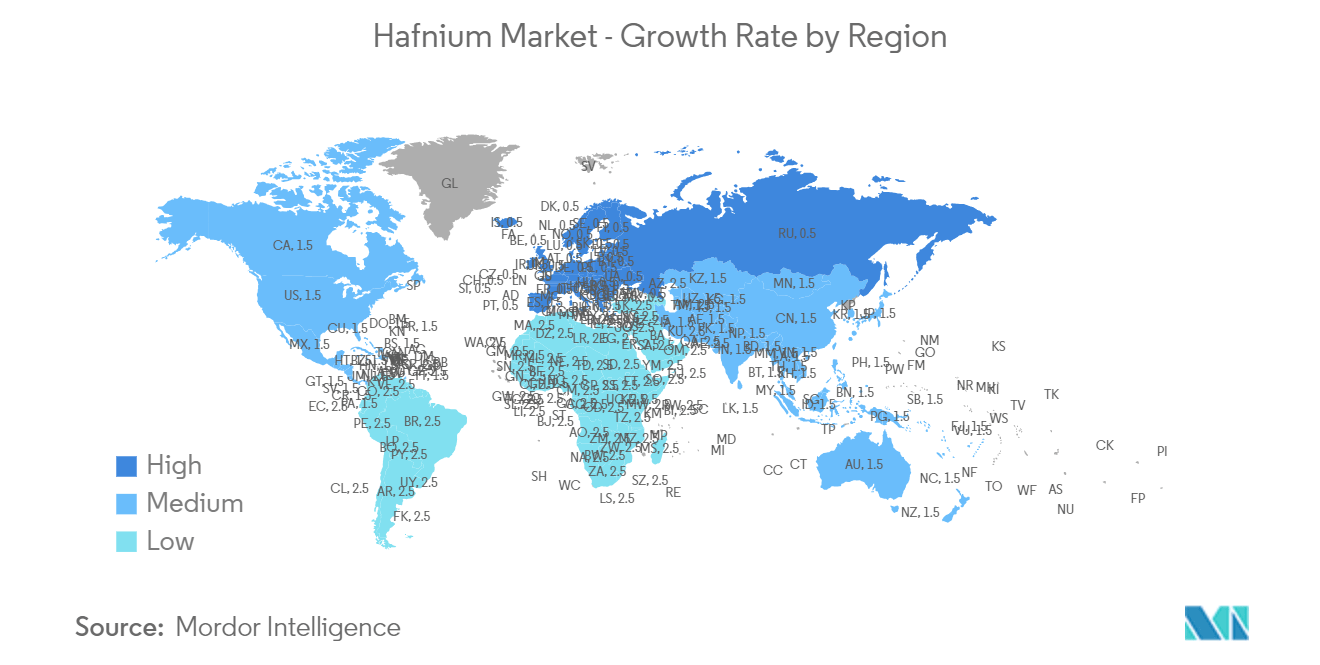Market Trends of Hafnium Industry
Super Alloys Application to Dominate the Market
- Hafnium is majorly used as a superalloy, and this application accounts for more than 50% of the total usage of hafnium. Due to its high strength and stability when operating at very high temperatures, hafnium is used as a superalloy for applications in aerospace and industrial turbines.
- Hafnium superalloys are mostly found in jet and rocket engines. Hafnium makes up roughly 10% of the niobium-based alloy used in rocket engine nozzles. It is regarded as indispensable in the MAR M 247 superalloy and is used in the hot section of jet engines (turbine blades and vanes).
- Hafnium superalloys are potentially used in industrial turbines, which are majorly used to produce electricity. Hence, the growing trends in the power generation industry and wind energy generation will favor the growth of hafnium superalloys.
- According to the International Energy Agency (IEA) statistics, global electricity generation continued to grow in 2022, increasing by 2.4% (nearly 700 TWh) year-over-year, which is similar to the average annual growth observed over the previous 5 years. In 2022, Global coal-fired electricity generation rose by nearly 2% (185 TWh). Coal as a source for electricity generation increased for the second year in a row, generating more than 10,000 Terawatt-hour (TWh), accounting for 36% of total generation. Moreover, according to the IEA forecasts, the installed coal power generation capacity will reach around 2,319 GW by 2025 globally, an increase from 2,271 GW in 2022.
- China has announced plans to install 1.7 gigawatts (GW) of electricity to power demand for China’s largest archipelago, comprised of 1390 islands, with lower emissions than coal-fired alternatives. In October 2023 - GE Vernova’s Gas Power business and Harbin Electric today announced that Chinese State Development & Investment Corp., Ltd. (SDIC) Jineng (Zhoushan) Gas Power Generation Co., Ltd. ordered two GE 9HA.02 gas turbines this power plant located in the Zhoushan archipelago.
- In May 2022, J-Power USA Development Co. Ltd. (J-POWER USA) achieved commercial operation with the first two Mitsubishi Power M501JAC gas turbines manufactured in North America at its Jackson generation project, a 1,200 megawatt (MW) combined-cycle power plant in Elwood, Illinois, United States.
- Owing to the rising importance of superalloys in various industries, the demand for the hafnium market is expected to grow during the forecast period.

China to Dominate the Asia-Pacific Region
- In China, hafnium is used in nuclear reactors, aircraft, industrial turbines, and other industries in the form of sponges, alloys, and other forms. Hafnium is used in nuclear reactors to make control rods due to its strong neutron-capture cross-section and neutron-absorbing capabilities.
- China's operable nuclear power capacity reached over 52,000 megawatts of electrical in 2022. In the same year, China had the third-largest operable nuclear power capacity worldwide after the United States and France.
- Nuclear power is expected to contribute about 10% of power generation in the country by 2035 and 18% by 2060, as per China’s Nuclear Energy Association.
- In September 2022, China approved two nuclear plants worth USD 11.5 billion, completing the list of 10 nuclear power units sanctioned by the country in 2022. The power plants are expected to sort out the country's crippling power shortage condition and trigger higher consumption of hafnium.
- In August 2023, authorities approved an additional six nuclear power units to be built at three plants, totaling ten nuclear power projects approved last year. New nuclear projects are expected to induce demand for hafnium for control rods used in the reactors in the forecast period.
- Hafnium oxide finds application in optical coatings and as a high dielectric in DRAM capacitors and advanced metal oxide semiconductor devices. China is the net importer of semiconductor chips, with China manufacturing less than 20% of semiconductors used. However, to benefit from the extensive demand scenario, China has embarked on strategic initiatives, like the Made in China 2025 plan, under which the Chinese government has announced its goal to reach an output of USD 305 billion by 2030 and, therefore, meet 80% of its domestic demand.
- The Chinese companies are stepping up efforts to push into the semiconductor industry. The Chinese government has subsidized semiconductor companies to build factories through various policy incentives. Some cities that have announced their plans for semiconductor production facilities include Chongqing, Shanghai, Beijing, Chengdu, Hefei, Shenzhen, Wuhan, Xiamen and Liaoning, and Shaanxi.
- Therefore, with the establishment of new semiconductor manufacturing facilities, the demand for hafnium oxide is expected to increase rapidly over the forecast period.
- China is also one of the leading aircraft manufacturers and one of the largest domestic air passenger markets. Furthermore, the country's aviation parts and assembly manufacturing sector has been quickly expanding, with over 200 minor aircraft parts manufacturers present.
- According to the Boeing Commercial Outlook 2022-2041, around 8,485 new deliveries will be made by 2041 with a market service value of USD 545 billion. The demand for hafnium will likely rise due to such new deliveries in the country.
- All the aforementioned factors, in turn, are expected to augment the consumption of hafnium in the country.

